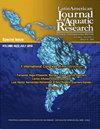不同保护条件下墨西哥红树林沉积物相关真菌的多样性和生物活性
IF 0.8
4区 农林科学
Q3 FISHERIES
Latin American Journal of Aquatic Research
Pub Date : 2023-07-02
DOI:10.3856/vol51-issue3-fulltext-2971
引用次数: 0
摘要
人们对红树林根际沉积物相关真菌的生物学重要性知之甚少,尤其是当它们在受干扰地区受到高盐度和厌氧菌的影响时。本研究评估了三种红树林根际沉积物中的真菌多样性,这些真菌多样性与保护区、半保护区和退化区红树林的三种保护条件有关。此外,真菌的生物活性与每个地区红树林物种的真菌多样性有关。我们分离到50株真菌,分属3门、7纲、10目。保存区的真菌多样性(H’=2.22)高于半保存区(H’=1.73)和退化区(H‘=1.68);冗余度分析表明,在保存区和半保存区,真菌有向芒根和阿维森尼根际积累的趋势。此外,冗余度分析表明,在保存区和半保存区,有10个具有生物活性的真菌属倾向于在芒根际和生发菌根际积累。保留区与半保留区相关,Jaccard相似系数为28%。分离真菌的多样性和生物活性促使人们需要保护和恢复红树林生态系统,考虑到它们目前和潜在的服务,例如生物勘探新的药理化合物。本文章由计算机程序翻译,如有差异,请以英文原文为准。
Diversity and bioactivity of sediment-associated fungi from a mangrove forest in Mexico with different conservation conditions
The biological importance of rhizosphere sediment-associated fungi in mangroves is poorly understood, especially when they are affected by high salinity and anaerobiosis in disturbed areas. This study evaluated the fungal diversity in the rhizosphere sediments of three mangrove species associated with three conservation conditions of mangrove forests in preserved, semi-preserved, and deteriorated areas. In addition, fungal bioactivity was correlated to the fungal diversity found in mangrove species from each area. We isolated 50 fungal strains belonging to three phyla, seven classes, and 10 orders. The fungal diversity was higher in the preserved area (H' = 2.22) than in the semi-preserved (H' = 1.73) and deteriorated areas (H' = 1.68); the redundancy analysis showed a tendency of fungal accumulation towards the rhizosphere of Rhizophora mangle and Avicennia germinans in the preserved and semi-preserved areas. In addition, the redundancy analysis showed that 10 bioactive fungi genera tended to accumulate on the rhizosphere of R. mangle and A. germinans in the preserved and semi-preserved areas. The preserved area is related to the semi-preserved area, with a 28% Jaccard similarity coefficient. The diversity and bioactivity of the isolated fungi encourage the need to conserve and restore mangrove ecosystems considering their current and potential services, such as bioprospecting new pharmacological compounds.
求助全文
通过发布文献求助,成功后即可免费获取论文全文。
去求助
来源期刊

Latin American Journal of Aquatic Research
FISHERIES-MARINE & FRESHWATER BIOLOGY
CiteScore
1.70
自引率
10.00%
发文量
44
审稿时长
4-8 weeks
期刊介绍:
Latin American Journal of Aquatic Research- LAJAR is the continuation of the journal Investigaciones Marinas (1970-2007) and is published since 2008 by the Escuela de Ciencias del Mar, Facultad de Ciencias del Mar y Geografía of the Pontificia Universidad Católica de Valparaíso. LAJAR is an “Open Access” journal that publishes in English language, original research articles, reviews and short communications on aquatic science, which contain the results of research conducted in aquaculture or in oceanic and coastal marine waters of Latin America.
The following topics are considered: Physical Oceanography, Chemical Oceanography, Marine Biogeochemistry, Marine Pollution and Toxicology, Marine Geology and Geophysics, Biological Oceanography, Fisheries and Aquaculture.
 求助内容:
求助内容: 应助结果提醒方式:
应助结果提醒方式:


